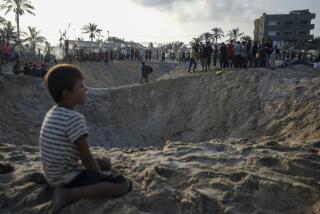Either We Can Do It or They Can Do It
- Share via
Some have criticized President Clinton for once again being outmaneuvered by Saddam Hussein’s brinkmanship, backing away from using force in the face of promises that he should know better than to believe.
However, the president correctly identified the longer-term solution. “The best way to address the Iraqi threat,” he said, would be to achieve “a new government” in Baghdad. The question now becomes how to achieve this goal. There are two options: We can do it or they can do it.
Option No. 1: We take down the Iraqi regime. Given the pattern of the Iraqi dictator’s behavior over the past six years, it is almost certain that he will challenge the U.S. and the international community again. The next time this happens, we would invade Iraq with the aim of liberating the country from his control. This option would require that the U.S. continue and expand the current military buildup in the Gulf rather than freezing it as the president appears to be doing. The U.S. would have to send the forces needed--including ground units--for liberating Iraq, while soliciting military and financial contributions from allies dependent on the region’s oil and those states of the region that are threatened by Saddam. This option would necessitate the deployment of a large force, perhaps not as large as the one we deployed to liberate Kuwait, since Iraq is militarily much weaker now than it was eight years ago. Nevertheless, such an intervention would be major undertaking and carries the risk of involving us in a protracted war in Iraq. However, it is the potentially quicker way.
Option No. 2: We assist the Iraqis in toppling their regime. For now, this is the better choice because it puts the Iraqis in the driver’s seat for determining their own future without the U.S. walking away from its responsibility. Some would argue that we have been doing this already, but in fact, our effort has been half-hearted and flawed. We made a mistake in not supporting the uprising by the Shiites and the Kurds after Desert Storm because we incorrectly believed that rebel gains would force the Sunni officers to rally around Saddam, thus undermining prospects for a military coup. The rebellion was brutally put down, but no coups took place.
Increasing our effort at promoting coups remains one way in which we can work for Saddam’s overthrow, but it is not sufficient. Coups are an uncertain business, and besides, whatever regime resulted from the coup would not necessarily be better than Saddam’s.
Galvanizing the extensive potential for opposition that exists in Iraq is a very promising route. Millions of Iraqis dislike Saddam, who has brought nothing but war, destruction and misery to their country. To tap this potential we must take the following steps:
First, encourage the establishment of a broad-based opposition, including Kurds, Shiites and Sunnis. Cooperation among the three main Iraqi communities is not only important for the struggle against Saddam but for reducing the prospects for a civil war later on. Our success in reconciling the two largest Kurdish opposition groups was an important first step. With the Sunnis, we must focus on the Western tribes, which have grown tired of Saddam.
The Iraqis have little reason to trust us given that we did not help them after Desert Storm and that we abandoned the opposition in 1996 after Saddam moved his forces into northern Iraq. Broadcasts of Radio Free Iraq and our other actions must signal that things will be different this time.
We also must provide economic, political and military support--training, intelligence and equipment. As in Desert Storm, the U.S. should seek allied, especially Saudi and Kuwaiti, financial contributions to meet the expense of supporting the Iraqi opposition. The Saudis and Kuwaitis will enjoy increased security. They also have benefited from the embargo on Iraq and can invest some of this in this effort. As far as costs are concerned, it should also be noted that deploying forces to the region each time Saddam stops cooperating with the U.N. has been very expensive for the U.S.
Lastly, the U.S. should gain Turkish support for such a strategy. The Turks are likely to support us if they believe that we are serious about getting rid of Saddam and that we have a plan with good prospects for ultimate success. Like Iraq’s Arab neighbors, the Turks are not willing to support symbolic gestures against Saddam that merely stir the pot but leave him in place.
Assuming that the president is serious about getting rid of Saddam, the best way to proceed for now is to make a sustained and serious effort at helping the Iraqi people shed their oppressive government and allow Iraq to take its proper place in the region and the world.
More to Read
Sign up for Essential California
The most important California stories and recommendations in your inbox every morning.
You may occasionally receive promotional content from the Los Angeles Times.













